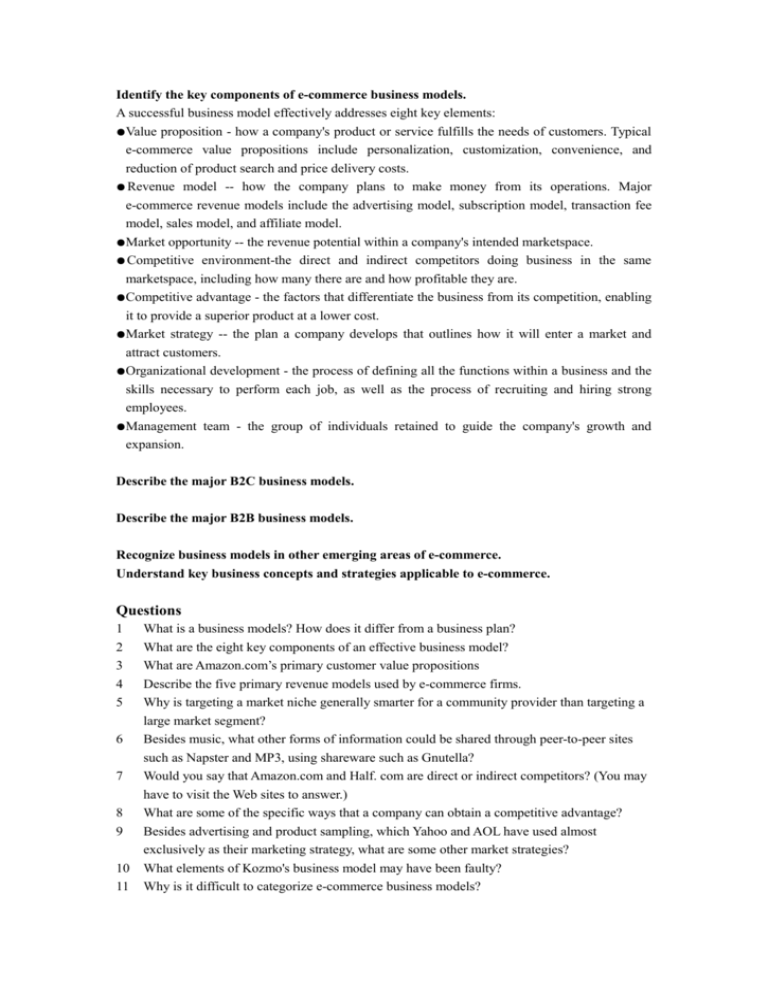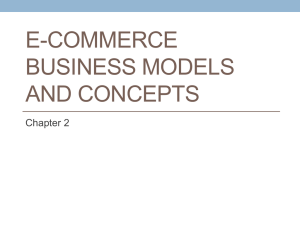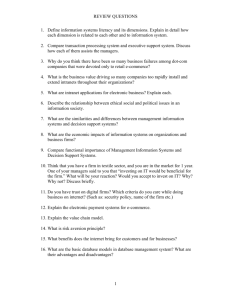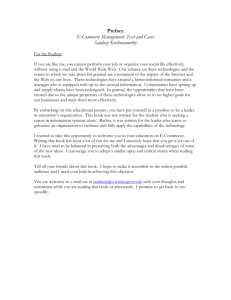Identify the key components of e
advertisement

Identify the key components of e-commerce business models. A successful business model effectively addresses eight key elements: ●Value proposition - how a company's product or service fulfills the needs of customers. Typical e-commerce value propositions include personalization, customization, convenience, and reduction of product search and price delivery costs. ● Revenue model -- how the company plans to make money from its operations. Major e-commerce revenue models include the advertising model, subscription model, transaction fee model, sales model, and affiliate model. ●Market opportunity -- the revenue potential within a company's intended marketspace. ● Competitive environment-the direct and indirect competitors doing business in the same marketspace, including how many there are and how profitable they are. ●Competitive advantage - the factors that differentiate the business from its competition, enabling it to provide a superior product at a lower cost. ●Market strategy -- the plan a company develops that outlines how it will enter a market and attract customers. ●Organizational development - the process of defining all the functions within a business and the skills necessary to perform each job, as well as the process of recruiting and hiring strong employees. ●Management team - the group of individuals retained to guide the company's growth and expansion. Describe the major B2C business models. Describe the major B2B business models. Recognize business models in other emerging areas of e-commerce. Understand key business concepts and strategies applicable to e-commerce. Questions 1 2 3 4 5 6 7 8 9 10 11 What is a business models? How does it differ from a business plan? What are the eight key components of an effective business model? What are Amazon.com’s primary customer value propositions Describe the five primary revenue models used by e-commerce firms. Why is targeting a market niche generally smarter for a community provider than targeting a large market segment? Besides music, what other forms of information could be shared through peer-to-peer sites such as Napster and MP3, using shareware such as Gnutella? Would you say that Amazon.com and Half. com are direct or indirect competitors? (You may have to visit the Web sites to answer.) What are some of the specific ways that a company can obtain a competitive advantage? Besides advertising and product sampling, which Yahoo and AOL have used almost exclusively as their marketing strategy, what are some other market strategies? What elements of Kozmo's business model may have been faulty? Why is it difficult to categorize e-commerce business models? 12 13 14 15 16 17 18 19 20 21 Besides the examples given in the chapter, what are some other examples of vertical and horizontal portals in existence today? What are the major differences between virtual storefronts, such as marthastewart.com, and clicks and bricks operations, such as walmart.com? What are the advantages and disadvantages of each? Besides news and articles, what other forms of information or content do content providers offer? What is a reverse auction? What company is an example of this type of business? What are the key success factors for B2B hubs? How are they different from portals? What is an application service provider? What are some business models seen in the consumer-to-consumer and peer-to-peer e-commerce areas? How have the unique features of e-commerce technology changed industry structure? Who are the major players in an industry value chain and how are they impacted by e-commerce technology? What are four generic business strategies for achieving a profitable business? Projects 1. Select an e-commerce company. Visit its Web site and describe its business model based on the information you find there. Identify its customer value proposition, its revenue model, the marketspace it operates in, who its main competitors are, any comparative advantages you believe the company possesses, and what its market strategy appears to be. Also try to locate information about the company's management team and organizational structure (check for a page labeled 'the Company,' 'About Us,' or something similar). 2. Examine the experience of shopping on the Web versus shopping in a traditional environment. Imagine that you have decided to purchase a digital camera (or any other item of your choosing). First, shop for the camera in a traditional manner. Describe how you would do so (for example, how you would gather the necessary information you would need to choose a particular item, what stores you would visit, how long it would take, prices, etc.). Next, shop for the item on the Web. Compare and contrast your experiences. What were the advantages and disadvantages of each? Which did you prefer and why? 3. Visit the eBay.com Web site and look at the many types of auctions available. If you were considering establishing a rival specialized online auction business, what are the top three market opportunities you would pursue, based on the goods and auction community in evidence at eBay? Prepare a slide presentation to support your analysis and approach. 4. During the E-commerce I era, first mover advantage was touted as one way to success. On the other hand, some suggest that being a market follower can yield rewards as well. Which approach has proven to be more successful - first mover or follower? Choose two e-commerce companies that prove your point, and prepare a brief presentation to explain your analysis and position. 5. Prepare a 3- to 5 page research report on the current and potential future impacts of e-commerce technology on the publishing industry.









